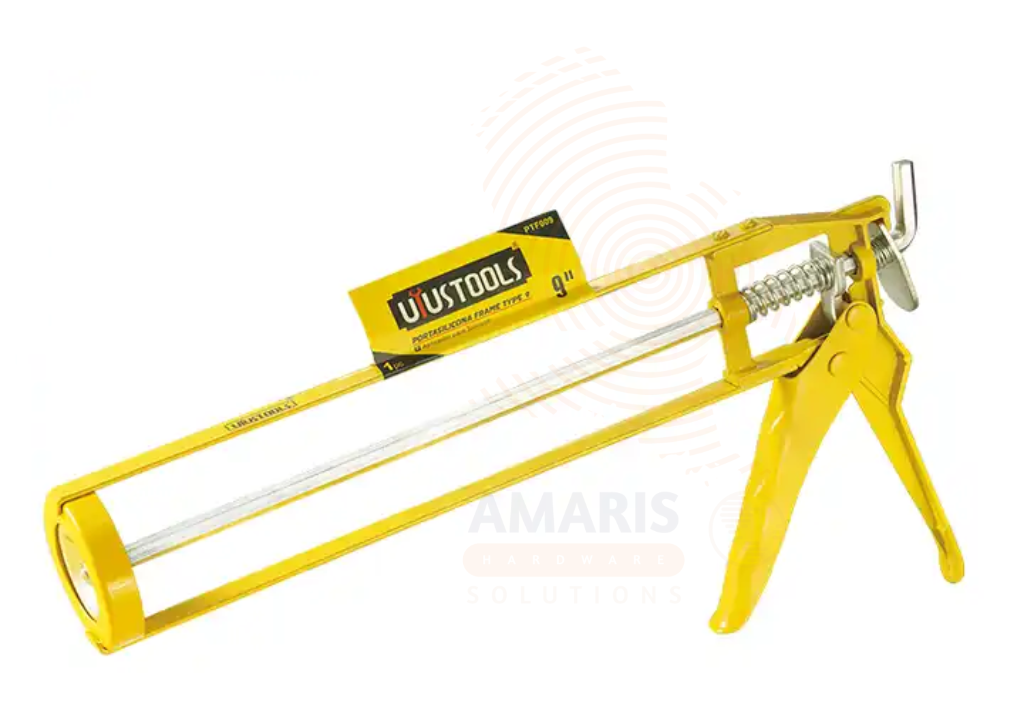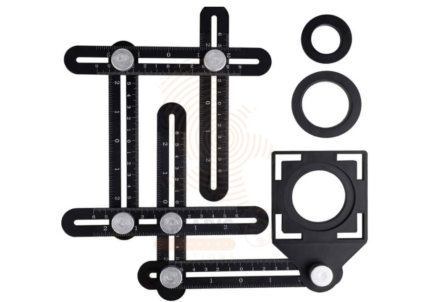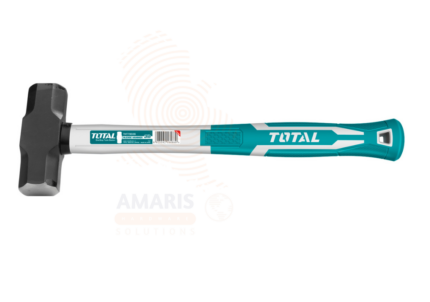Skeleton Caulk Gun
WhatsApp Order
A “skeleton caulk gun” refers to a type of caulk gun that features a skeletal or open-frame design. Unlike standard caulk guns, which have a solid body enclosing the caulk tube, a skeleton caulk gun has a minimalistic structure with an open frame that allows the user to see the caulk cartridge inside. This design provides better visibility of the caulk level, making it easier for the user to monitor and control the application of caulk. Skeleton caulk guns are commonly used in construction and home improvement projects for sealing joints and gaps with precision.
Description
Table of Contents
ToggleSkeleton Caulk Gun
Uses
-
Sealing Joints and Gaps:
-
The primary purpose of a skeleton caulk gun is to apply caulk or sealant to joints, gaps, and seams in various construction materials.
-
It is often used around windows, doors, baseboards, and other areas where there may be gaps that need sealing.
-
-
Weatherproofing:
-
Skeleton caulk guns are instrumental in weatherproofing projects. They help create a watertight and airtight seal to prevent water infiltration and drafts.
-
-
Caulking Trim and Molding:
-
When installing or repairing trim and molding, a skeleton caulk gun allows for precise application of caulk to create a seamless and finished appearance.
-
-
Construction and Renovation:
-
In both new construction and renovation projects, skeleton caulk guns are used to seal joints between different building materials, ensuring structural integrity and preventing air or moisture penetration.
-
-
DIY Home Repairs:
-
Homeowners often use skeleton caulk guns for various DIY projects, such as repairing cracks in walls, sealing gaps in the bathroom or kitchen, and other maintenance tasks.
-
-
Automotive Applications:
-
In automotive maintenance and repair, a skeleton caulk gun can be used for applications like sealing joints, seams, or gaps in a vehicle’s exterior to prevent leaks and rust.
-
-
HVAC System Sealing:
-
Skeleton caulk guns are utilized in HVAC (heating, ventilation, and air conditioning) projects to seal joints and connections, helping to maintain energy efficiency and prevent air leaks.
-
-
Plumbing Repairs:
-
Plumbers may use skeleton caulk guns to apply sealant around pipes and fixtures, ensuring a watertight seal and preventing leaks.
-
-
Concrete Joint Sealing:
-
In construction projects involving concrete, skeleton caulk guns are employed to seal joints and expansion gaps to prevent water infiltration and protect the structure from damage.
-
-
General Household Maintenance:
-
From fixing small cracks in walls to sealing gaps around fixtures, a skeleton caulk gun is a handy tool for general household maintenance tasks.
-
SAFETY HANDLING PRECAUTIONS
Safety Precautions
-
Read the Instructions:
-
Familiarize yourself with the manufacturer's instructions and guidelines provided with the skeleton caulk gun. This will help you understand the proper usage and any specific safety recommendations.
-
-
Wear Personal Protective Equipment (PPE):
-
Consider wearing appropriate personal protective equipment, such as safety glasses or goggles, to protect your eyes from splashes or accidental contact with caulk.
-
-
Choose the Right Caulk:
-
Select the correct type of caulk or sealant for your specific application. Different projects may require different formulations, and using the right product ensures better performance.
-
-
Inspect the Gun Before Use:
-
Check the skeleton caulk gun for any damage or defects before use. Make sure that all moving parts are functioning correctly, and there are no cracks or issues with the frame.
-
-
Handle with Care:
-
Treat the caulk gun with care to avoid damage. Avoid dropping it, and be mindful of the nozzle and other parts to prevent any breakage or malfunction.
-
-
Load and Unload Safely:
-
When loading or unloading the caulk cartridge, follow proper procedures to avoid accidentally dispensing caulk. Keep your hands away from the trigger until you are ready to apply.
-
-
Use Caution with Sharp Objects:
-
Be cautious when cutting the tip of the caulk cartridge. Use a utility knife or a designated caulk-cutting tool, and cut away from your body to prevent accidental injuries.
-
-
Control the Dispensing Speed:
-
Practice controlling the trigger to dispense caulk at a steady and controlled pace. Avoid applying too much pressure on the trigger, as it can result in excess caulk being dispensed.
-
-
Ventilate the Area:
-
If you are working in a confined space, ensure proper ventilation to disperse fumes from the caulk. Some caulks may emit odors or fumes, and good ventilation helps prevent inhalation.
-
-
Clean Up Spills Promptly:
-
If any caulk spills onto surfaces or skin, clean it up promptly. Use appropriate cleaning agents and follow safety guidelines for the specific caulk being used.
-
-
Store Properly:
-
Store the caulk gun and unused cartridges in a cool, dry place. Follow the manufacturer's recommendations for storage conditions to maintain the quality of the caulk.
-
-
Keep Children and Pets Away:
-
Keep children and pets away from the work area to prevent accidental exposure to caulk or other potential hazards.
-
Related products
Bi-Metal Hole Saw Set
A 9 PCS Bi-Metal Hole Saw Set refers to a collection of nine hole saws, each constructed with a bi-metal design. A hole saw is a cylindrical cutting tool used to create holes in various materials such as wood, metal, plastic, and more. The term "bi-metal" indicates that the hole saws are made from two different types of metals, typically high-speed steel (HSS) and a more durable alloy like cobalt. This combination enhances the hole saw's cutting performance, making it suitable for a wide range of applications and providing increased durability and longevity. The set typically includes hole saws of different sizes to accommodate various hole diameters, making it a versatile tool for professionals and DIY enthusiasts alike.
C Clamp Locking Pliers
A C clamp locking pliers, often simply referred to as locking pliers or Vise-Grips (a popular brand name), is a versatile hand tool designed for gripping, clamping, and holding objects securely. The tool features an adjustable locking mechanism that allows it to maintain a constant grip force on the object, freeing the user's hands for other tasks. The jaws of the pliers are shaped like a C-clamp, providing a strong and secure grip on various shapes and sizes of objects. This makes C clamp locking pliers particularly useful in situations where a stable hold is required, such as in woodworking, metalworking, automotive repair, and general DIY applications.
Carpenter’s Pencil – Hexagon
A Carpenter's Pencil Hexagon refers to a pencil specifically designed for carpentry work, characterized by its hexagonal shape. Unlike traditional round pencils, the hexagonal shape of a Carpenter's Pencil prevents it from rolling off surfaces and provides a more secure grip, making it practical for precision and control in carpentry tasks. The design also allows for easy identification and retrieval among other tools on a busy work site. Additionally, Carpenter's Pencils often feature a flat or rectangular cross-section, further preventing them from rolling and making them convenient for marking lines with straight edges.
Circlip pliers set
A circlip pliers set typically refers to a collection of four different types or sizes of circlip pliers, which are specialized tools designed for installing or removing circlips (also known as snap rings) in various applications. Circlips are small, ring-shaped fasteners that fit into machined grooves on a shaft or inside a bore to secure components in place.
The set may include internal circlip pliers and external circlip pliers, each in two different sizes or configurations. Internal circlip pliers are used to install or remove circlips inside a bore, while external circlip pliers are designed for circlips located on the outside of a shaft. The variety in the set allows for versatility in handling different sizes and types of circlips, making it a comprehensive tool kit for various mechanical tasks.
Combination spanner set
A combination spanner set typically refers to a collection of twelve different-sized spanners that feature both open-end and box-end configurations. Combination spanners are versatile tools commonly used in mechanical and household applications. The open end is designed to grip fasteners in tight spaces, while the box end provides a more secure grip on the flats of a nut or bolt.
The set usually includes a range of sizes to accommodate various fastener dimensions. Each spanner in the set may be marked with its specific size, typically in metric or imperial units. This versatile tool set is essential for tasks that require tightening or loosening nuts and bolts in different applications, providing flexibility and convenience for the user.
Double – End Bits Set
PRODUCT DESCRIPTION
A Double-End Bits Set typically refers to a collection of interchangeable tool bits designed for use with screwdrivers, power drills, or similar tools. Each bit in the set has two distinct ends with different types or sizes of tips, allowing the user to perform various tasks without needing multiple individual bits. These sets often include a variety of common bit types, such as Phillips, slotted, Torx, or hex, providing versatility for different screw and fastener types. The double-ended design allows users to flip the bit and switch between different tips easily, making it a convenient and space-saving solution for various applications.
Flat Cold Chisel with Guard
PRODUCT DESCRIPTION
A flat cold chisel with a guard is a hand tool designed for cutting, shaping, or removing metal by striking it with a hammer. The chisel has a flat, elongated metal blade with a sharp cutting edge at one end. The guard, often made of metal or another protective material, is positioned along the sides of the blade to enhance safety during use. This guard helps prevent accidental injuries by shielding the user's hand from direct contact with the sharp edge and also provides stability to the chisel during striking. The flat cold chisel with a guard is commonly used in metalworking and construction applications.
Flat Hand Steel File
PRODUCT DESCRIPTION
A flat hand file is a type of hand tool used in metalworking and woodworking to remove material from a workpiece by abrasion. It consists of a flat, elongated piece of metal with parallel rows of teeth or ridges, called the file's "cut," which are designed to cut or shape a material when rubbed against it. Flat hand files are typically rectangular in shape and come in various sizes and coarseness grades, allowing for different levels of material removal and finishing. These files are commonly used for smoothing, shaping, and leveling surfaces in a variety of applications, providing a versatile means of material removal in manual craftsmanship.


 Acrylic Sealants
Acrylic Sealants Construction Adhesives
Construction Adhesives Double-Sided Tape
Double-Sided Tape Duct Tape
Duct Tape Electrical Tape
Electrical Tape Epoxy & Resins
Epoxy & Resins Masking Tape
Masking Tape
 Automotive Wrenches & Socket Sets
Automotive Wrenches & Socket Sets Battery Chargers & Jump Starters
Battery Chargers & Jump Starters Car Jacks & Stands
Car Jacks & Stands Car Wash & Detailing Products
Car Wash & Detailing Products Diagnostic Tools
Diagnostic Tools Tire Inflators
Tire Inflators Vehicle Lighting
Vehicle Lighting Oil & Lubricants
Oil & Lubricants
 Adhesives & Sealants
Adhesives & Sealants Bricks & Blocks
Bricks & Blocks Cement & Concrete
Cement & Concrete Drywall & Plaster
Drywall & Plaster Flooring (Tiles, Wood, Laminate)
Flooring (Tiles, Wood, Laminate) Lumber & Plywood
Lumber & Plywood Paints, Primers & Coatings
Paints, Primers & Coatings Insulation Materials
Insulation Materials Roofing Materials
Roofing Materials
 Circuit Breakers
Circuit Breakers Electrical Cables & Wires
Electrical Cables & Wires Switches & Sockets
Switches & Sockets Fuses & Relays
Fuses & Relays Connectors & Terminals
Connectors & Terminals Electrical Boxes & Panels
Electrical Boxes & Panels Conduit & Fittings
Conduit & Fittings Lighting Fixtures & Bulbs
Lighting Fixtures & Bulbs Extension Cords & Power Strips
Extension Cords & Power Strips
 Anchors
Anchors Bolts
Bolts Clips & Clamps
Clips & Clamps Screws
Screws Nuts
Nuts Washers
Washers Rivets
Rivets Nails
Nails Threaded Rods
Threaded Rods
 Hammers
Hammers Measuring Tools (Tapes, Levels, Calipers)
Measuring Tools (Tapes, Levels, Calipers) Screwdrivers
Screwdrivers Pliers & Cutters
Pliers & Cutters Saws & Blades
Saws & Blades Chisels & Punches
Chisels & Punches Allen Keys & Hex Keys
Allen Keys & Hex Keys Ratchets & Socket Sets
Ratchets & Socket Sets Wrenches & Spanners
Wrenches & Spanners
 Power Tool Accessories (Blades, Bits, Discs)
Power Tool Accessories (Blades, Bits, Discs) Rotary Tools
Rotary Tools Saws (Circular, Jigsaw, Reciprocating)
Saws (Circular, Jigsaw, Reciprocating) Drills & Drivers
Drills & Drivers Grinders & Sanders
Grinders & Sanders Heat Guns
Heat Guns Nail Guns
Nail Guns Impact Wrenches
Impact Wrenches Batteries & Chargers
Batteries & Chargers
 Pipes & Fittings (PVC, Copper, PEX)
Pipes & Fittings (PVC, Copper, PEX) Plumbing Tools
Plumbing Tools Pumps & Motors
Pumps & Motors Sealants & Adhesives for Plumbing
Sealants & Adhesives for Plumbing Valves & Taps
Valves & Taps Water Heaters
Water Heaters Drainage Systems
Drainage Systems Faucets & Fixtures
Faucets & Fixtures Hoses & Tubing
Hoses & Tubing
 Hinges & Latches
Hinges & Latches Hooks & Brackets
Hooks & Brackets Window Hardware
Window Hardware Chains & Cables
Chains & Cables Casters & Wheels
Casters & Wheels Shelving & Storage Systems
Shelving & Storage Systems Door Handles & Locks
Door Handles & Locks Drawer Slides & Cabinet Hardware
Drawer Slides & Cabinet Hardware
 Personal Protective Equipment (PPE)
Personal Protective Equipment (PPE) Respirators & Masks
Respirators & Masks Safety Glasses
Safety Glasses Safes
Safes Security Cameras
Security Cameras Gloves
Gloves Helmets
Helmets Ear Protection
Ear Protection Fire Safety Equipment
Fire Safety Equipment Locks & Padlocks
Locks & Padlocks Motion Sensors & Alarms
Motion Sensors & Alarms
 Garden Fencing
Garden Fencing Garden Furniture Hardware
Garden Furniture Hardware Lawn Mowers
Lawn Mowers Trimmers & Edgers
Trimmers & Edgers Shovels & Spades
Shovels & Spades Rakes & Hoes
Rakes & Hoes Pruning Shears & Loppers
Pruning Shears & Loppers Watering Systems (Hoses, Sprinklers, Nozzles)
Watering Systems (Hoses, Sprinklers, Nozzles)
 Interior Paints
Interior Paints Paint Brushes & Rollers
Paint Brushes & Rollers Paint Strippers & Thinners
Paint Strippers & Thinners Paint Trays & Accessories
Paint Trays & Accessories Exterior Paints
Exterior Paints Spray Paints
Spray Paints Primers & Undercoats
Primers & Undercoats Varnishes & Stains
Varnishes & Stains
 Gaskets & Seals
Gaskets & Seals Hydraulic Fittings
Hydraulic Fittings Industrial Fasteners
Industrial Fasteners Industrial Hoses
Industrial Hoses Lubricants & Greases
Lubricants & Greases Metal Sheets & Bars
Metal Sheets & Bars Bearings & Bushings
Bearings & Bushings Belts & Pulleys
Belts & Pulleys
 HVAC Filters
HVAC Filters Insulation for HVAC
Insulation for HVAC Air Conditioners
Air Conditioners Refrigerants
Refrigerants Ventilation Ducts & Fittings
Ventilation Ducts & Fittings Thermostats & Controllers
Thermostats & Controllers Fans & Blowers
Fans & Blowers
 Pegboards & Hooks
Pegboards & Hooks Shelving Units
Shelving Units Storage Bins & Containers
Storage Bins & Containers Toolboxes & Tool Chests
Toolboxes & Tool Chests Workbenches
Workbenches Drawer Organizers
Drawer Organizers Labeling Supplies
Labeling Supplies
 Welding Accessories (Clamps, Brushes)
Welding Accessories (Clamps, Brushes) Welding Electrodes & Rods
Welding Electrodes & Rods Welding Helmets & Gloves
Welding Helmets & Gloves Welding Machines
Welding Machines Soldering Irons & Stations
Soldering Irons & Stations Flux & Solder Wire
Flux & Solder Wire
 Generator Accessories
Generator Accessories Inverters
Inverters Portable Generators
Portable Generators Power Inverters
Power Inverters Transfer Switches
Transfer Switches Diesel & Gasoline Generators
Diesel & Gasoline Generators
 Transport Equipment: Carts, Dollies, and Hand Trucks
Transport Equipment: Carts, Dollies, and Hand Trucks Storage Solutions: Pallets, Racks, and Containers
Storage Solutions: Pallets, Racks, and Containers Lifting Equipment: Hoists, Cranes, and Jacks
Lifting Equipment: Hoists, Cranes, and Jacks Conveyors and Accessories: Belts and Rollers
Conveyors and Accessories: Belts and Rollers






